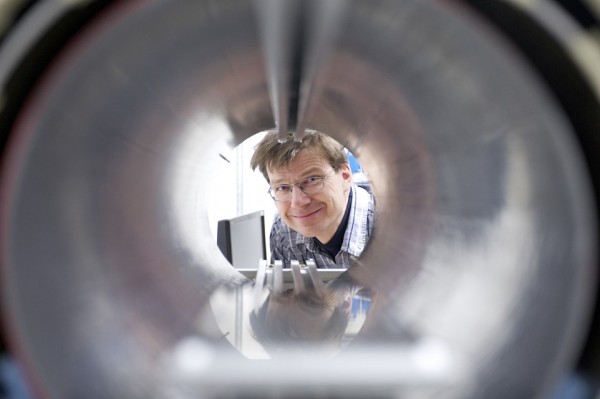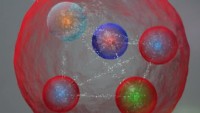Neutrons can now be measured accurately—study
| Eana Maniebo | | Oct 05, 2015 02:37 PM EDT |
(Photo : PSI) Klaus Kirch, Head of the Laboratory of Particle Physics at PSI, at a test setup for the measurement of the neutron electric dipole moment. The researchers have devised a new method to measure ultra-cold neutrons, which may help to explain why considerably more matter than antimatter was formed during the Big Bang.
According to physics, the only way to explain the reason behind protons' dominance over neutrons in terms of quantity and presence in the universe is through the electric dipole moment (EDM), or by determining the amount of the separation between positive and negative electrical charges in an electrical charge system.
Like Us on Facebook
Unfortunately, the problem is that the existing methods for EDM remain inaccurate or lacking the capacity to precisely detect a proton-neutron discrepancy. However, in a recent announcement released by the Paul Scherrer Institute (PSI), scientists claim that their independent study on such ended up successful, saying that a new brand of EDM has been discovered.
Philipp Schmidt-Wellenburg and his colleagues said that they have developed a detection technique called spin-echo method that is capable of measuring slow-moving neutrons, which is done by a non-destructive imaging methodology that could measure high-precision neutron movement.
"We send neutrons - our 'runners' - off with a kind of starting shot. After a certain time, we turn them around with a second signal. All the neutrons then return to the starting point like an echo," Schmidt-Wellenburg told PSI's official website.
It turned out that the delay in neutron's crossing of so-called "finish line" actually gives observers a clear view of their natural movement within the electrical charge system. "Similarly, in a group of equally sporty runners, if one made it back later than the rest, it would suggest that there were more obstacles on their course," he explained further.
The spin-echo has been around for decades now and has been used in detecting images of tissue and other organs. What the PSI scientists had to do is alter its capabilities so that they could cope with the speed of neutrons in an electric charge, which is very slow.
"We have to balance out even tiny changes in the magnetic field, which can even come about if a lorry drives past on the nearby road, for instance," added Schmidt-Wellenburg.
The study is in line with the organization's aim to explain the discrepancy surrounding the universe's structure, in which it shows that it is mostly made up of positively charged matter. The detection of neutrons could lead to deeper understanding of why matter and antimatter particles did not completely eradicate themselves when they collided during the Big Bang.
A few months earlier, Thunder Energies Corporation (OTCQB: TNRG), a company known for its revolutionary earth-friendly fossil fuel and coal combustion technology and nuclear instruments, has taken the world of astronomy and science aback upon unveiling its newest product, the Santilli Telescope. This optical instrument for space exploration is the first in history that successfully detect antimatter particles.
The inception of this telescope has earned the "revolutionary" moniker from various entities across the scientific world as this is the first time that antimatter particles have been proven existent outside a mathematical equation. This will also be available in the world market through distributorship, according to the company in recent interviews.
Moreover, last March, a group of scientists and researchers from the University of Maryland and the National Institute of Standards and Technology said that they successfully found a method that could detect neutrons emitted by radioactive light.
According to Christopher Lavelle, a scientist at Johns Hopkins University Applied Physics Laboratory and the project's lead researcher, this could be done through a boron-coated vitreous carbon foam put in xenon gas. Through which, they found out that neutrons captured deep within the coated foam are creating detectable flashes outside the foam. The boron-10 isotope in the coating is capable of absorbing neutrons in a split second, which then leads to the release of energetic particles into the gas, creating large flashes of light.
Tagsneutrons, electric dipole moment, Paul Scherrer Institute, spin-echo method, antiparticle discovery, antimatter discovery, Thunder Energies Corporation, Ruggero Santilli, Santilli telescope, Large Hadron Collider, Astrophysics, matter particles, Antimatter
©2015 Chinatopix All rights reserved. Do not reproduce without permission
EDITOR'S PICKS
-

Did the Trump administration just announce plans for a trade war with ‘hostile’ China and Russia?
-

US Senate passes Taiwan travel bill slammed by China
-

As Yan Sihong’s family grieves, here are other Chinese students who went missing abroad. Some have never been found
-

Beijing blasts Western critics who ‘smear China’ with the term sharp power
-

China Envoy Seeks to Defuse Tensions With U.S. as a Trade War Brews
-

Singapore's Deputy PM Provides Bitcoin Vote of Confidence Amid China's Blanket Bans
-

China warns investors over risks in overseas virtual currency trading
-

Chinese government most trustworthy: survey
-

Kashima Antlers On Course For Back-To-Back Titles
MOST POPULAR
LATEST NEWS
Zhou Yongkang: China's Former Security Chief Sentenced to Life in Prison

China's former Chief of the Ministry of Public Security, Zhou Yongkang, has been given a life sentence after he was found guilty of abusing his office, bribery and deliberately ... Full Article
TRENDING STORY

China Pork Prices Expected to Stabilize As The Supplies Recover

Elephone P9000 Smartphone is now on Sale on Amazon India

There's a Big Chance Cliffhangers Won't Still Be Resolved When Grey's Anatomy Season 13 Returns

Supreme Court Ruled on Samsung vs Apple Dispute for Patent Infringement

Microsoft Surface Pro 5 Rumors and Release Date: What is the Latest?












